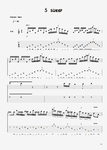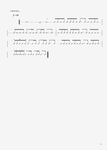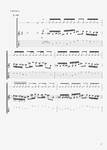degenaro":2h49uipy said:
glpg80":2h49uipy said:
BeZo":2h49uipy said:
You have to practice accuracy and develop speed. That said, slow down and practice a lot.
You'll get it.
+ to all of this
with sweep picking, its all about playing lightly and without much effort at the end of the day - practice using a light finger touch approach and not "with a heavy hand"
right hand technique is as much important as left hand technique. when starting to go up the fretboard vertically starting on the high e, always start with a downpick and then slide up. when starting at the low e going down, start with an up stroke and slide down. the sliding motion should be uniform with the finger motion and the time that you change notes with your fingers dictates how long that note will ring out - by not pressing on the note for too long, you're automatically muting the notes you do not want to play. noise is controlled on open strings by sweeping your right hand across the note just after you fret the next following note in the arpeggio.
what really gets fun is when you start mixing tap and tap+slides with arpeggio sweeps. that takes alot of practice as it takes you out of your comfort zone of having your hand next to the bridge.
no matter where you are - get rid of the metronome for now and practice very very very slow, make sure you practice correct technique, dont practice your mistakes or you will play your mistakes - its all about control and doing it lightly/effortlessly and smoothly.
its has everything to do with technique and what works for you in how you hold your pick.
You had me until the "toss the metronome comment". Why?
The technique, or any technique for that matter will NEVER get absorbed correct when practicing it without any meaningful reference. That is why sweeping 16ths stuff at 90 bpm is harder than 16th triplets at 120. Because if you don't have the technique down what saves you at faster speed is that you can just slop through it by targeting down beats. But maybe there's something I'm not getting...
For that matter the two things that I come to realize that are WAY MORE IMPORTANT THAN TIME ON THE INSTRUMENT IS internalizing rhythm...(put a metronome on your iphone and drive around with a click track singing rhythms to the click)...and spedning time on ear training.
if you noticed the next few words, it is practice very very very slowly. so slow a metronome wont help you. you need to get the technique down and the feel of it down first, and then worry about repetative practice using a metronome and applying it in a beat.
if you practice it slowly but with a heavy hand then it wont matter that you know rhythm or can apply it - you will never be able to do it cleanly when changing hand and finger positions at the same time. its extremely important to get this feeling thing down and understand fluidity with sweep picking. it is definately something that has to be practiced properly or you will develop improper technique and therefore limit yourself - these are things that need attention without a metronome at first. you have to walk before you can run.
if you cannot get this feeling down, no matter how fast you are you will find out your limits very quick trying to speed things up. develop it properly from the start - and the speed will come on its own since sweep picking is a fluid mechanic feeling. the next hardest thing to tackle for me, is expanding your arpeggio vocabulary so that you can apply it in beats in songs and make the arpeggios match the song - instead of playing some random arpeggio you might know that does not belong there in a musical sense at all.
with this, comes even more important notes on the technique i mentioned. the habbits you develop will transfer to all modal forms of arpeggios - it is best to concentrate on them now and not in the future.
ear training? thats a whole different topic in itself - its insanely important with anything you do - vocals, guitar, tuning, rhythm, etc




